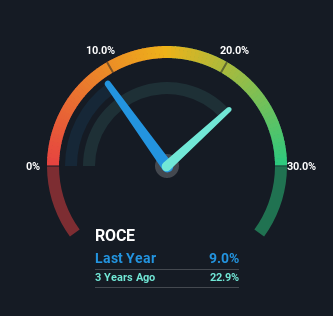- India
- /
- Consumer Durables
- /
- NSEI:WHIRLPOOL
Capital Allocation Trends At Whirlpool of India (NSE:WHIRLPOOL) Aren't Ideal

What are the early trends we should look for to identify a stock that could multiply in value over the long term? In a perfect world, we'd like to see a company investing more capital into its business and ideally the returns earned from that capital are also increasing. If you see this, it typically means it's a company with a great business model and plenty of profitable reinvestment opportunities. However, after investigating Whirlpool of India (NSE:WHIRLPOOL), we don't think it's current trends fit the mold of a multi-bagger.
Return On Capital Employed (ROCE): What is it?
If you haven't worked with ROCE before, it measures the 'return' (pre-tax profit) a company generates from capital employed in its business. To calculate this metric for Whirlpool of India, this is the formula:
Return on Capital Employed = Earnings Before Interest and Tax (EBIT) ÷ (Total Assets - Current Liabilities)
0.09 = ₹3.4b ÷ (₹53b - ₹15b) (Based on the trailing twelve months to December 2021).
Thus, Whirlpool of India has an ROCE of 9.0%. In absolute terms, that's a low return and it also under-performs the Consumer Durables industry average of 13%.
See our latest analysis for Whirlpool of India

While the past is not representative of the future, it can be helpful to know how a company has performed historically, which is why we have this chart above. If you're interested in investigating Whirlpool of India's past further, check out this free graph of past earnings, revenue and cash flow.
The Trend Of ROCE
In terms of Whirlpool of India's historical ROCE movements, the trend isn't fantastic. Around five years ago the returns on capital were 28%, but since then they've fallen to 9.0%. Although, given both revenue and the amount of assets employed in the business have increased, it could suggest the company is investing in growth, and the extra capital has led to a short-term reduction in ROCE. If these investments prove successful, this can bode very well for long term stock performance.
The Bottom Line
In summary, despite lower returns in the short term, we're encouraged to see that Whirlpool of India is reinvesting for growth and has higher sales as a result. In light of this, the stock has only gained 31% over the last five years. So this stock may still be an appealing investment opportunity, if other fundamentals prove to be sound.
Whirlpool of India does have some risks though, and we've spotted 1 warning sign for Whirlpool of India that you might be interested in.
While Whirlpool of India may not currently earn the highest returns, we've compiled a list of companies that currently earn more than 25% return on equity. Check out this free list here.
Valuation is complex, but we're here to simplify it.
Discover if Whirlpool of India might be undervalued or overvalued with our detailed analysis, featuring fair value estimates, potential risks, dividends, insider trades, and its financial condition.
Access Free AnalysisHave feedback on this article? Concerned about the content? Get in touch with us directly. Alternatively, email editorial-team (at) simplywallst.com.
This article by Simply Wall St is general in nature. We provide commentary based on historical data and analyst forecasts only using an unbiased methodology and our articles are not intended to be financial advice. It does not constitute a recommendation to buy or sell any stock, and does not take account of your objectives, or your financial situation. We aim to bring you long-term focused analysis driven by fundamental data. Note that our analysis may not factor in the latest price-sensitive company announcements or qualitative material. Simply Wall St has no position in any stocks mentioned.
About NSEI:WHIRLPOOL
Whirlpool of India
Manufactures and markets home appliances in India and internationally.
Excellent balance sheet with reasonable growth potential.
Market Insights
Community Narratives




